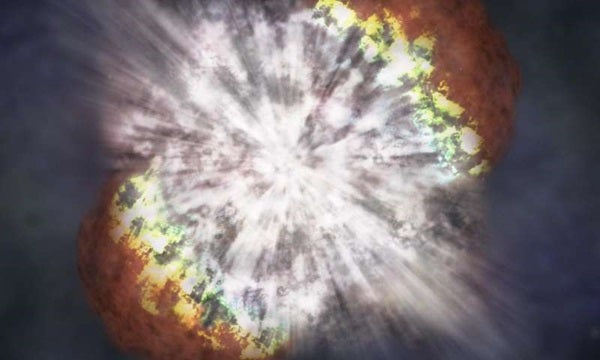Most supernovae explode only once, but a newly found superluminous star did something truly bizarre: it exploded twice.
A recently discovered class of supernovae called superluminous supernovae (SLSN) are brighter and longer-lasting. Only a dozen or so have been found, and using the Gran Telescopio CANARIAS (GTC), astronomers have found evidence of another, but reveals surprising behavior. It seems to have exploded not only once, but twice. The findings are published in The Astrophysical Journal Letters.
There are several different types of supernovae; the most well known type Ia, where a white dwarf star absorbs mass from another star or collides with another white dwarf which causes a thermonuclear explosion as its mass becomes unstable. The other types of supernovae are caused when massive stars use up all their fuel and can no longer fuse atoms together in its core. They then collapse under their own gravity causing a supernova.
The research has revealed that the supernova had an initial increase in brightness, declined for a few days, then increased again even stronger than before.
“Superluminous supernovas are up to a hundred times more energetic than type Ia supernovae because they can remain bright for up to six months before fading, rather than just a few weeks,” explains Mathew Smith, the lead author of the study and a postdoctoral researcher at the University of Southampton, in a press release. “What we have managed to observe, which is completely new, is that before the major explosion, there is a shorter, less luminous outburst, which we can pick out because it is followed by a dip in the light curve, and which lasts just a few days.”
This is the first time something like this has ever been observed in a supernova.
“From our data, we have tried to determine if this is a characteristic unique to this object, or whether it is a common feature of all superluminous supernovae, but has not been observed before, which is perfectly possible given their unpredictable nature,” Smith says.
Discovered on December 21, 2014, the object was given the name DES14X3taz by the Dark Energy Survey (DES) which studies the expansion of the universe through dark energy, but occasionally detects supernovae and other transient phenomenon.
As soon as DES14X3taz was found, the GTC made it a priority for two nights of observation on January 26 and February 6, 2015. The GTC is able to devote some of its time to these transient objects as they may offer unrepeatable opportunities.
The GTC has a 10.4 meters mirror that, when combined with its powerful spectroscopy instrument, make it the ideal tool to observe SLSNe. Using data from the GTC and other telescopes, Smith and his team were able to reconstruct the brightness of DES14X3taz almost from the moment of its detection. They have determined its absolute brightness with great precision and its distance of 6.4 billion light-years.
The researchers concluded, after comparing their observations to many models, that the most plausible explanation is the birth of a magnetar, or a neutron star rotating very rapidly on its axis. The initial peak, decline, then quick rise back to brightness is consistent with that of an emission of a huge bubble of material that cools as it grows.
“We think that a very massive star, some 200 times the mass of the Sun, collapses to form a magnetar. In the process, the first explosion occurs, which expels into space a quantity of matter equivalent to the mass of our sun, and this gives rise to the first peak of the graph,” says Smith to Phys.org. “The second peak occurs when the star collapses to form the magnetar, which is a very dense object rotating rapidly on its axis, and which heats up the matter expelled from the first explosion. This heating is what generates the second peak in the luminosity.”
Understanding this process may allow astronomers to “standardize” the model for SLSN as has already happened for type Ia supernovae. Its large luminosity makes these objects ideal candidates for calculating distances on larger scales and with greater accuracy than with current techniques. First is understanding their origin and their nature.
Until now, the only other examples of SLSNe have been in small galaxies with low metallicity (small amounts of heavy elements), which is still not well understood. Smith says, “it is a part of the mystery of these objects.” A huge priority to continue studying these objects is to detect more of the SLSNe and observe them from the moment they explode in real time with a telescope comparable in size to the GTC.
Source: Phys.org










